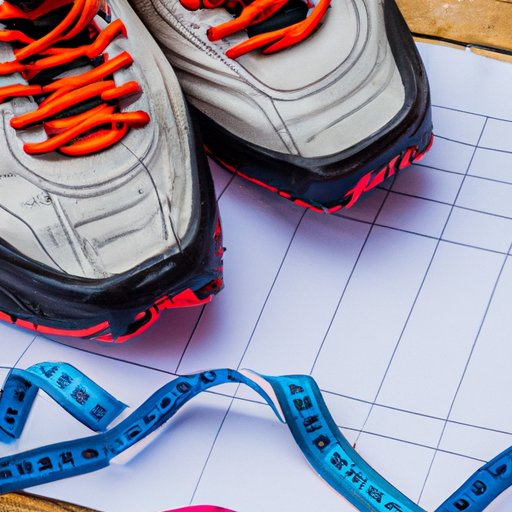Introduction
Weight loss is a common goal for many people looking to improve their overall health and wellbeing. While diet plays a role in weight loss, exercise can help you reach your goals faster and more effectively. With the right approach, you can use exercise to lose weight in a safe and sustainable way.
Overview of the Problem
When it comes to losing weight, it’s important to understand that there’s no one-size-fits-all solution. What works for one person may not work for you. Everyone has a unique body type, fitness level, and lifestyle, so it’s important to create a plan tailored to your needs and goals.
Purpose of the Article
This article will provide an in-depth guide on how to effectively lose weight with exercise. It covers topics such as creating a tailored workout plan, incorporating interval training, lifting weights, monitoring your diet, tracking progress, finding support and staying motivated.
Create a Workout Plan
The first step in any weight loss program is to create a workout plan. This plan should be tailored to your individual goals and fitness level. You don’t need to spend hours in the gym every day; even just a few minutes of exercise each day can make a huge difference.

Tailor Your Exercise Regimen to Your Goals and Fitness Level
Your workout plan should be tailored to your individual goals and fitness level. If you’re just starting out, start slow and gradually increase the intensity and duration of your workouts as you get stronger and fitter. On the other hand, if you’re already a seasoned athlete, you can focus on high-intensity interval training (HIIT) to maximize calorie burning.

Consider Different Types of Exercises
In addition to aerobic activities like running, swimming, and cycling, consider adding some strength and resistance training into your workout plan. This can help build muscle, which will help you burn more calories even when you’re not exercising.
Incorporate Interval Training
Interval training is a great way to maximize calorie burning and get the most out of your workouts. It involves alternating intense bursts of activity with short periods of rest. For example, you could sprint for one minute followed by a one-minute walk, or do 10 burpees followed by one minute of jumping jacks.
Lift Weights
Strength training is another effective way to lose weight. Lifting weights helps build muscle, which increases your metabolism and allows you to burn more calories even when you’re not exercising. Aim to include at least two days of strength training in your weekly workout routine.
Benefits of Strength Training
Strength training has many benefits beyond just weight loss. It can help improve your posture, reduce stress and anxiety, and boost your energy levels. Plus, it’s fun and can be done anywhere!

Building Muscle for Efficient Calorie Burning
When you lift weights, you’re building muscle. This increases your resting metabolic rate, meaning you’ll be burning more calories even when you’re not exercising. Building muscle also helps your body become more efficient at burning fat, so you’ll be able to reach your weight loss goals faster.
Monitor Your Diet
Exercise alone won’t necessarily lead to weight loss. To see results, you need to combine exercise with a healthy diet. Eating healthier foods, reducing portion sizes and avoiding processed foods can all help you reach your goals.
Eating Healthier Foods
Focus on eating whole, unprocessed foods like fruits, vegetables, lean proteins, and whole grains. Avoid sugary drinks and processed snacks, as these can sabotage your efforts. Also, opt for low-fat dairy products and watch your intake of unhealthy fats like trans fats and saturated fats.
Reducing Portion Sizes
Portion control is key when it comes to weight loss. Even if you’re eating healthy foods, it’s still important to pay attention to how much you’re eating. Try using a smaller plate or bowl to help you stay mindful of your portion sizes.
Track Progress
Tracking your progress can help keep you motivated and on track. Using a calorie-tracking app or journal can help you monitor your progress and make adjustments to your plan accordingly.
Using a Calorie-Tracking App or Journal
There are many apps available to help you track your calories, such as MyFitnessPal or Lose It!. You can also keep a food journal to record what you eat and how much. This can help you identify areas where you can make changes to your diet.
Adjusting Your Plan According to Progress
Once you’ve been tracking your progress for a few weeks, take a look at your data and adjust your plan accordingly. Are you seeing results? If not, you may need to increase the intensity or duration of your workouts or make changes to your diet.
Get Support
It can be difficult to stay motivated when you’re trying to lose weight. Having a support system can make a big difference. Consider joining a fitness class or finding an online support group to help keep you accountable and motivated.
Joining a Fitness Class
Group classes are a great way to stay motivated and have fun while working out. Plus, the instructor can offer tips and advice to help you reach your goals.
Finding an Online Support Group
If you’re more of an introvert, an online support group can be a great option. There are plenty of online forums and social media groups dedicated to helping people reach their fitness goals.
Find Motivation
Staying motivated is key to achieving your weight loss goals. Setting challenging but achievable goals and rewarding yourself when you reach them can help keep you motivated and on track.
Setting Challenging Goals
Set goals that are realistic and achievable, but still challenging. This will help you stay focused and motivated on your journey to weight loss.
Rewarding Yourself When You Reach Them
When you reach your goals, reward yourself! Whether it’s a massage, a night out, or a new outfit, celebrating your success can help keep you motivated and on track.
Conclusion
Losing weight with exercise can be a challenge, but it’s possible with the right approach. Creating a tailored workout plan, incorporating interval training, lifting weights, monitoring your diet, tracking progress, finding support and staying motivated are all key to reaching your weight loss goals. With dedication and consistency, you can achieve your goals and enjoy a healthier, happier life.
(Note: Is this article not meeting your expectations? Do you have knowledge or insights to share? Unlock new opportunities and expand your reach by joining our authors team. Click Registration to join us and share your expertise with our readers.)
